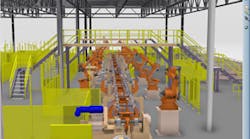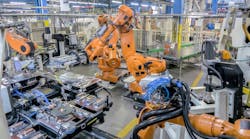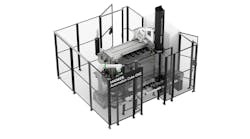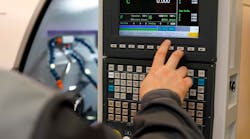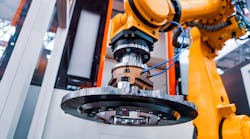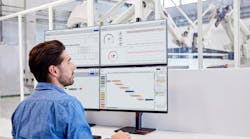Digital retrofitting develops a new production facility in a virtual world using the exterior structure and measurements of a former operation. Companies retrofit the factory by simulating the transition to new tooling and equipment, and then simulating the new production processes that will occur once the tooling update is completed.
Machinists and industrial equipment manufacturers continually look for ways to increase efficiency and profit margins, and ultimately some details must be sacrificed. The manufacturing economy is in a transition, in which we’re embracing sustainable technologies, making do with fewer personnel resources and expecting greater productivity with limited risk. While extra vacation may be temporarily expendable – technology is not. To continue to innovate and develop better-quality products faster, manufacturers need proper equipment and a work facility conducive to success. The question is: how does a company already struggling to stay afloat suddenly create a new factory where its employees can shine?
The answer is digital retrofitting: taking an old, outdated and sometimes even abandoned factory space and, using digital simulation, modifying the structure ergonomically, functionally and environmentally. Bricks, mortar, labor and land don’t come cheaply, and digital retrofitting allows companies that otherwise would not be able to afford a certain location or plant size make another company’s previous residence their own.
Digital retrofitting involves building a new factory in a virtual world using an old factory’s exterior structure and measurements. Companies retrofit the factory by simulating the transition to new tooling and equipment, and then simulating the new production processes that will occur once the tooling update is completed. Because the factory design is virtual, engineers and designers can collaborate easily to determine the most practical ergonomic tweaks that the factory will support, determine the viability of a proposed project, flag potential problems and fix those problems before anyone does so much as lay down a tarp.
Like digital prototyping, digital retrofitting lets manufacturers adjust and interact with a factory long before physical structures have been altered. It’s a lot easier to edit a simulation program than it is to put up a new concrete wall in the middle of a factory during peak production.
There are plenty of potential risks to taking a building that was designed for one specific purpose and transforming it to support another. Some companies are reluctant to undertake the process of digital retrofitting for fear of wedging a square peg into a round hole. However, retrofitting a factory digitally isn’t a haphazard endeavor; before starting any work in the real-world, machinists can ensure that equipment can be moved and replaced and guarantee that the factory in question can handle the new production processes.
Digitally retrofitting a factory before actual work begins can provide a manufacturer with a strategic and competitive advantage. Manufacturers can apply digital retrofitting to improve the efficiency of their existing facilities, but most importantly, to make a previously-owned factory reflect the design and composition of their choosing.
Acquisition and alteration
Machine shops and plants are continually coming “offline” and facilities are retired as companies change locations, consolidate operations or as the wave of baby boomer machinists in their golden years leave the workforce. When these natural situations occur, they create opportunities for other manufacturers to invest capital in an existing building and begin production quickly. Taking control of a pre-existing facility eliminates the need to build a factory “from scratch” and saves time that otherwise would be spent procuring permits, dealing with politics and planning. Digital retrofitting can reduce costs and accelerate time to production not only from a facilities perspective, but also from a human resources perspective. As one company leaves a community, it also leaves an eager workforce that can be trained or reeducated to support a new company’s needs.
When transitioning a factory from one company to another, it makes the most sense from the vantage point of risk and efficiency for both companies to be in the same sector. For example, the risks are inherently lower when industrial equipment supplier moves into a factory where another once operated, rather than a manufacturer of injection molding machines taking over a candy factory. As the differences increase between what a factory once produced and what it will produce in the future, so do the risks involved.
However, digital retrofitting can mitigate those risks while providing all the same benefits provided companies are willing to put in additional time and effort. If a traditional automotive manufacturer vacates a facility and an electric vehicle manufacturer moves in, the tooling and equipment may change, but many of the processes involved in how the product moves through the line may require a similar layout that can be easily visualized. On the other hand, if that same factory will soon be used for an entirely different industry – perhaps to manufacture jewelry or toys – changes within the four walls will be significant. Either way, the changes can first be made digitally to prove viability, identify potential issues in the retooling process and create ways to solve any issues that may arise.
Enhancing existing assets
Additionally, in today’s economic environment where flexibility is critical, there are many scenarios where it makes sense for machinists to retrofit their existing factories. A company may want to retire a product and retool a factory to create a new one, or it may simply want to improve production by making operations run smoother. Ergonomic improvements, for instance, can have a very positive impact on worker productivity, especially for assembly lines.
Over the past few years, many companies have been forced to reduce staff and idle facilities. As the global economy slowly adjusts to a new era these companies will retain a much stronger competitive advantage by adhering to lean principles (reducing process bottlenecks and maximizing the value in each stage of the product lifecycle). As industrial equipment demand increases, manufacturers should look for ways to make the most of existing resources. A time may come where expanding into a new facility – or retrofitting someone else’s facility – makes sense, but meeting demand with current resources is certainly a safer and more affordable way to stay afloat.
For instance, instead of dedicating a factory to the manufacture of a single component, a business could alter an existing factory and enable it to produce multiple models. A factory that can produce impact riveting machines as well as orbital and radial riveting machines is much more cost-efficient than it would be if it supported two separate facilities, and as a result it can more accurately meet production demand.
When time is money and deadlines are non-negotiable, retrofitting an old factory is a relatively quick way to meet process-intensive goals. Digitally retrofitting a factory makes corporate transitions less painful and ameliorates risk at a time when unexpected downtime could cost millions. Patrick Michel is vice president for Solutions & Marketing, DELMIA, Dassault Systèmes, a developer of 3D and PLM software.
